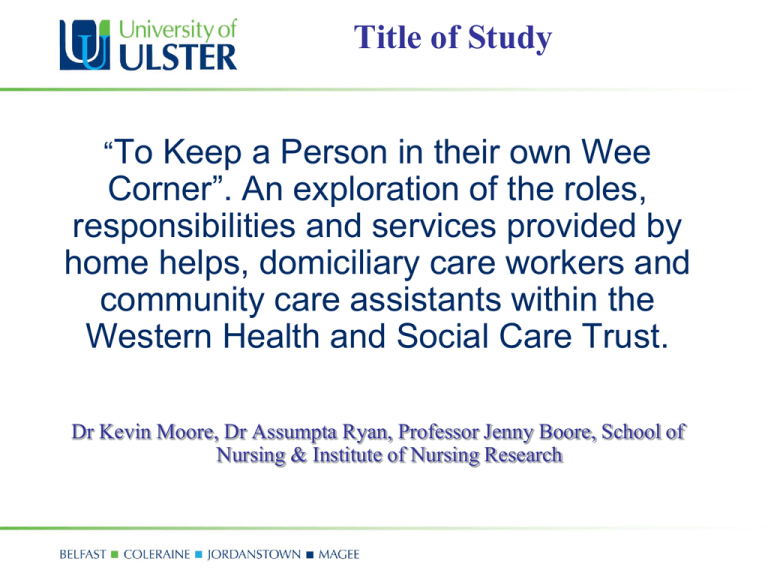Roles, responsibilities and services provided by home helps +
advertisement

Title of Study “To Keep a Person in their own Wee Corner”. An exploration of the roles, responsibilities and services provided by home helps, domiciliary care workers and community care assistants within the Western Health and Social Care Trust. Dr Kevin Moore, Dr Assumpta Ryan, Professor Jenny Boore, School of Nursing & Institute of Nursing Research ‘A cradle to grave concept’ Background & Strategic Drivers Dearth of published material on role of domiciliary care workers Government legislation, reports, initiatives, policy drivers Influence of local, national and worldwide demographic trends Aim The overall aim of this study was to explore the roles and responsibilities of home helps and domiciliary care workers within WHSCT Methodology A Two Phased study utilising qualitative and quantitative approaches Phase 1: A Grounded Theory approach, Qualitative methods using focus groups, semi-structured interviews and community forum meeting. Phase 2: Quantitative approach utilising a questionnaire, derived from Phase 1, which further tested the emergence of theory from phase 1. Phase 1 findings reported today! Methodology Why Grounded Theory? “Grounded Theories, because they are drawn from the data, are likely to offer insight, enhance understanding and provide a meaningful guide to action” (Corbin & Strauss, 2008). Constant comparative analysis Theoretical sampling Theoretical sensitivity Data Collection Phase 1 Focus Group interviews (n=11) [total of 128 participants]. Semi structured qualitative interviews with all senior managers across WHSCT (n=3). All interviews recorded and transcribed verbatim. 1 community forum meeting (n=48), field notes/observations and theoretical memos recorded. Data Management & Analysis Open, axial and selective coding. Field notes/observations & theoretical memos. Multiple Diagrams. Emergence of sub-categories to support core category? Initially manual analysis of transcripts, then NVivo. Checking of theoretical construction against participant's meaning of phenomenon (Chiovitti & Piran, 2003, p427) Paradigm Model Paradigm Model (A) CAUSAL CONDITIONS (C) CONTEXT (B) PHENOMENON (D) INTERVENING CONDITIONS (E) ACTION/INTERACTION STRATEGIES (F) CONSEQUENCES Core Category There is a disconnect between the perceived centrality of the role of the home help/DCW and the recognition of importance of role within the wider Health and Social Care Community Key Findings Location of Care The Characteristics of Carers Caring and the Caregiving Relationship Role Identification Role Challenges Role Conflict Location of Care “You do understand that my next door neighbour might be 4 or 5 fields away”. (Interviewee 21) “So I do the things I do because I care for my client, who is after all, my neighbour, and indeed whilst they might live miles from me see, I see them and theirs as an extension to my own family.” (Interviewee 49) “Come on Bridie, it’s all very well talking about this to yer man here but if we don’t get on with it they’ll be talking about you and me in the post office” (Interviewee 19) Role Identification “Helping to give choice, respect, listening to what they’ve got to say. I love my job”. (Interviewee 52) “Knowing that I make a difference to the quality of my client’s daily lives and making them so happy. I feel valued and trusted actually”. (Interviewee 16) “It’s the interaction with the clients, the relationships you build and the support of the team it’s such a worthwhile service”. (Interviewee 48) Role Challenges “I feel that this is a very stressful job role and I personally feel that I am not delivering quality care it’s upsetting really!” (Interviewee 43) “That it takes too long when you report to a supervisor for additional help or equipment until it appears, it’s upsetting all round!” (Interviewee 77) Role Conflict “I’m not a home help, I’m here to do personal care, not home help and if you need those services, well then see a social worker”.(Interviewee 25) “The roles are becoming closer now home helps are being trained to do personal care”. (Interviewee 24) “We’re now getting hounded over sick leave and overtime as every week somebody is off on sick leave”. (Interviewee 80) Characteristics of Carers “I like working with elderly people and I feel I’ve good life experiences especially in respecting sick and vulnerable people?” (Interviewee 15) “Caring for clients and knowing that I have made a difference to their overall well-being is very important to me”. (Interviewee 2) “Giving my work 100% is important to me. I would always go over and above the call of duty and this doesn’t bother me at all, it’s who I am”. (Interviewee 1) Caring and the Care Giving Relationship “Because you're doing personal care, washing and dressing that doesn’t mean to say that that’s all that has to be done, nor indeed is it all that I will do either”. (Interviewee 7) “Plus, whenever you’re dealing with the same patients week after week, you can monitor their progress, and see if they are ok, or are feeling depressed, we basically become part of their family too and care for them like our own”. (Interviewee 20) “Everybody likes their own wee corner at the end of the day….and if there’s enough good positive care provided by us in the community, well then it’ll stop them from being shipped into a nursing home”. (Interviewee 152) Recommendations A training need analysis, linked in a strategic manner to a Nationally Recognised and Accredited Framework, such as NVQ. Current training and support mechanisms must be inclusive of client assessment and client evaluation. Home care staff must participate in a collegiate manner with such assessments & care reviews. The home is clearly the ‘hub’ , an operational definition of this is needed. Continued monitoring and review of the impact of home care on older adult’s meaning of home and its potential impact on their recovery. Recommendations Clinical supervision and supervisor support arrangements must place value on the role of its home care workers. Complex client assessments for home care must be underpinned in a collaborative and collegiate manner using the Northern Ireland Single Assessment Tool (2009). Quality assurance mechanisms must extrapolate on how home care workers experience and negotiate their work on a daily basis, thus enabling effective responding to staff needs and compliance with legislative and regulatory frameworks. The Integrated Service Delivery Model (DHSS&PS NI, 2011) must be implemented as a priority for effective service delivery. Home care for the older person must be based on reablement, Jones et al. (2009). Implications Location of care delivery Health & Social Care provision at an organisational level with appropriate responsiveness training The caring trajectory for the client within the concept of caring Continuity of caring ethos within a person centred practice framework Responding to the process of change with an effective model for practice Questions? kd.moore@ulster.ac.uk aa.ryan@ulster.ac.uk References Chiovitti, R.F & Piran, N., (2003). Rigour and grounded theory research. Journal of Advanced Nursing. 44(4), 427–435 Corbin, J., Strauss, A., (2008). Basics of Qualitative Research, 3rd Edition. London: Sage Publications. Cutcliffe, J.R., (2000). Methodological issues in grounded theory. Journal of Advanced Nursing, 31 (6), 1476-1488 Department of Health Social Services & Public Safety, Northern Ireland. (2011). Transforming your Care: A Review of Social Care in Northern Ireland, December 2011. DHSS&PS NI. Belfast: HMSO. Department of Health (2009). Investigating the Longer term Impact of Homecare re-ablement Services; the short-term outcomes and costs of homecare re-ablement services, interim report. Authors Jones et. al. October 2009 Working Paper No. DHR2378. York. The Publications Office, Social Policy Research Unit. Northern Ireland Single Assessment Tool [NISAT], (2009). http://www.dhsspsni.gov.uk/index/hss/eccommunity-care/ec-northern-ireland-single-assessment-tool.htm Last Accessed. June 2012.







